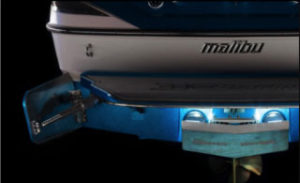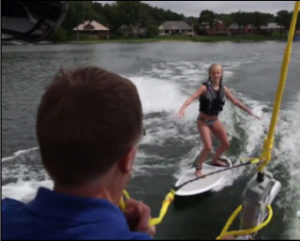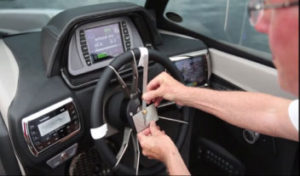
Surf System Comparison
Gen 2 Surf System, or Surf Gate? - Here's a Study to Help you Decide.
Do you have questions about surf systems, how they work, and which one is truly a smarter purchase? Let us answer these questions for you with unbiased FACTS. In an independent study, research was done on the two most popular wake surf systems on the market, the MasterCraft Gen 2 Surf System vs Malibu Surf Gate. The results speak for themselves as to which system is a better buy.
Study Conducted By:

Jim Dowd
Jim is a senior consulting, product development and R&D professional with more than 30 years of experience in the transportation industry in Europe and the US. Jim has served on Technical Advisory Boards and his skills in new product creation have been recognized with the award of more than 20 US patents.

Dr. Steve Zalek
Steve is the President of SeaSystems Research LLC and also the Associate Director of the University of Michigan Marine Hydrodynamics Laboratory.
Tested Surf Systems
Three boats from both MasterCraft and Malibu were tested against each other, each being paired to the boat that closely resembled its size. Each boat was equipped with their brand's surf system - MasterCraft with a Gen 2 Surf System and Malibu with Surf Gate.
Tests Performed
The boats were loaded with factory ballast according to the manufacturers recommended settings and adjusted for surfing on port and starboard sides. Using a combination of cameras, floating markers, and sensors, data points on wake size and length were collected.
-
MasterCraft Gen 2

-
Malibu Surf Gate

Surf System Test Results Compared in:
Push Results
-
Wave Observations:
In all 3 boat classes, the Gen 2 equipped boats produced more substantial wakes than that those with Surf Gate. The X46 generated 24% more wave energy than the 24MXZ, the X30 wave energy was 2% more than the 23LSV and the NXT wave energy was 3% more than the Axis 22.
-
Consumer Conclusion
All 6 boats tested produced long wakes allowing amateur surfers to surf as much as 18 feet back from the boat. The results show that wake length is not a big differentiator between Surf Gate and Gen 2 since all boats product surfable length within 2 feet of one another. On the other hand, the push coming from the height and width of the wakes gave the advantage to Gen 2 in all 3 boat size classes.
Air Quality
Carbon Monoxide Level Results
Noise Level
-
Carbon Monoxide Level Observations
All boats measured 0 parts per million (PPM) at the driver’s seat and so these readings are not tabulated. In the rear seat location, there was no measured accumulation of CO in the Mastercraft boats. The Malibu boats, however had measured accumulations averaging more than 50 PPM. Measurements taken 3 feet aft of the transom produced the highest readings for all boats with the Malibu boats averaging 343 PPM and the Mastercraft boats averaging 42 PPM.
-
Consumer Conclusion
With surf systems deployed and averaging measurements from the 3 sampling zones:
- Mastercraft NXT operated at an average of 6 PPM compared to an average of 140 on Axis 22
- Mastercraft X30 operated at an average of 70 PPM compared to an average of 285 on Malibu 23LSV
- Mastercraft X46 operated at an average of 33 PPM compared to an average of 221 on the Malibu 24 MXZ
Noise Level Results
Steering Handling
-
Noise Level Observations
All boats had comfortably low sound levels at the driver and rear seat zones. In these locations the measurements for the Gen 2 equipped Mastercraft boats were between 1 to 3 dB lower than the Surf Gate equipped boats. As expected, all boats had higher noise reading immediately behind the boats with the NXT quieter that the Axis 22 and the Malibu 23LSV and 24MXZ quieter than their respective Gen 2 equipped Mastercraft boats.
-
Consumer Conclusion
The Mastercraft NXT was quieter than the Axis 22 in all 3 sound measurement zones. The other 2 Mastercraft boats were quieter inside and noisier outside than their respective Malibu benchmarks.
- Mastercraft NXT operated at an average of 3Db lower noise level that the Axis 22
- Mastercraft X30 operated at an average of 1.33 Db lower noise level than the Malibu 23 LSV
- Mastercraft X46 operated at an average of 1.33 Db lower noise level than the Malibu 24 MXZ
Steering Handling Results
-
Observations
The boats with Surf Gate required greater steering wheel angle rotation in all 3 boat size classes. In 5 of the 6 boats tested, the steering wheel effort needed to correct the heading change was relatively effortless 3lbs or less. The outlier in the force testing was the Malibu 23LSV that required 14lbs to bring the boat back on course.
-
Consumer Conclusion
In terms of perceived effort, the wheel rotation force is judged to be more important than the actual angle of wheel rotation. Consequently, the force required to counteract the Surf Gate deployment on the Malibu 23LSV is a negative.
Pitch
Pitch When Using Surf System Results
-
Observations
Both 20-foot boats exhibited more bow rise than the longer boats with the Axis pitching 11.8 degrees compared to 11.6 for the Mastercraft NXT.
The 23-foot boats exhibited identical pitch at 10.2 degrees and the Mastercraft X46 had the lowest reading of 7.7 degrees.
-
Consumer Conclusion
The bow rise that resulted from acceleration to surf speed was within 2 degrees on 5 out of 6 of the boats. The Mastercraft X46 rode considerably flatter at 7.7 degrees of pitch. Forward vision was accommodated with the use of bolster seats on 5 out 6 of the boats. The Axis 22 test boat however, did not have a bolster seat and so the driver had to stand in order to get a clear view forward.
User Interface
Comparing User Interface Results
Observations
The 23 and 24-foot class comparison resulted in very similar number of steps. The surf control systems for all 4 of these boats were easy to comprehend and operate. The major difference in ease of use was in the 20-foot comparison between the Axis 22 and the Mastercraft NXT, the MasterCraft system being easier to use. View picture for details.
Summary
Summary of Results
This chart summarizes how the MasterCraft Gen 2 and the Malibu Surf Gate systems stack up relative to one another in each of the boat size categories. The comprehensiveness of the study and the range of performance measurements accumulated over several days of testing should be sufficient to answer all questions consumers may have relative to the performance of these systems.
Want to See for Yourself?
Below is the video presentation of the study narrated by Jim Dowd and Dr. Steve Zalek. To read the study, click below.
Summary of Results
This chart summarizes how the MasterCraft Gen 2 and the Malibu Surf Gate systems stack up relative to one another in each of the boat size categories. The comprehensiveness of the study and the range of performance measurements accumulated over several days of testing should be sufficient to answer all questions consumers may have relative to the performance of these systems.



